LHRH C화학적 특성, 용도, 생산
Indications
GnRH (gonadorelin, luteinizing hormone–releasing
hormone) is a decapeptide that stimulates production
of LH and FSH. It is released in bursts from the hypothalamus
at regular intervals, about every 2 hours, although
in women the interval may lengthen in the luteal
end of the menstrual cycle.The pituitary gland responds
to these regular pulses by producing LH and FSH. The
pattern of LH and FSH in cycling women, including the
large burst of LH release before ovulation, can be stimulated
by regular administration of GnRH pulses. The
large burst of LH from the pituitary gland appears to be
induced by feedback through estradiol and other products
of the gonads that change the response of the pituitary
gland to the GnRH pulses rather than by large
changes in the amounts of GnRH secreted. The stimulatory
response to GnRH depends on pulsatile administration
and the timing of the pulses. Continual administration
of GnRH does not have the same effects as
pulsatile administration; although production of LH
and FSH is stimulated initially, it is suppressed within a
few days. Part of this desensitization to GnRH is caused
by a decrease in the number of pituitary receptors for
GnRH; additional postreceptor mechanisms are also
important in this complete suppression.
Biological Functions
Gonadotropin-releasing hormone (GnRH) is a decapeptide that causes the release of
the gonadotropins, luteinizing hormone (LH) and follicle-stimulating hormone (FSH), from the
anterior pituitary gland, but not in equal amounts (FSH release is partially inhibited by the
gonadal protein inhibin). Therefore, GnRH is intimately involved in the control of both male and
female reproduction. Medicinal chemists have capitalized on the relatively simple decapeptide
structure of GnRH by preparing many analogues as potential fertility and antifertility agents,
several of which are commercially available, especially those that are referred to as
superagonists. It is known that GnRH can be degraded by enzymatic cleavage between Tyr5-
Gly6 and Pro9-Gly10. Structure–activity relationship studies of GnRH analogues have shown
that when Gly6 is replaced with certain D-amino acids, as well as with changes in the peptide C terminus, they generally are less susceptible to proteolytic enzymes, resulting in a longer lasting action. For that reason, they are referred to as superagonists. Furthermore, when these
D-amino acids at position 6 are hydrophobic, the half-life is enhanced.
Mechanism of action
In physiological doses, GnRH agonists are able to induce ovulation and spermatogenesis by increasing LH and FSH levels and the resulting sex steroid levels, as does the normal hormone. In larger pharmacological (therapeutic) doses, however, GnRH agonists, especially the superagonists, block implantation of the fertilized egg, cause luteolysis of the corpus luteum, and can act as postcoital contraceptive agents (although not approved for this latter use). This paradoxical antifertility effect seen with the superagonists has been attributed to the fact that GnRH must be administered in a low-dose, pulsatile manner for it to be therapeutically effective as a fertility agent. Natural GnRH release from the hypothalamus occurs in a pulsatile manner. When GnRH or, especially, a superagonist is administered in pharmacological doses each day, LH and FSH levels will initially rise but then begin to fall after a few days because of target tissue desensitization/downregulation of pituitary GnRH receptors. The continued use of these agents in a nonpulsatile manner will result in a drastic drop of the gonadal steroid levels to near castrate levels in both males and females, thereby giving rise to their use in such conditions as precocious puberty, endometriosis, and advanced metastatic breast and prostate carcinoma.Typically, however, the GnRH superagonists take approximately 2 weeks to finally desensitize
the GnRH receptors, and during this time, there is a transient rise in LH and FSH levels, which
often results in an initial “flare-up” of the original symptoms.
Clinical Use
Oxytocin is generally considered to be the drug of
choice for inducing labor at term. In combination with
amniotomy, oxytocin is highly successful in inducing
and augmenting labor. When given oxytocin, approximately
80% of patients with documented labor disorders
progress into labor and deliver vaginally. It has also
been used following incomplete abortion after 20 weeks
of gestation (although use of prostaglandins may be
preferred in this instance), and it may be used after fullterm
delivery to prevent or control uterine hemorrhage.
Oxytocin in high doses is used to induce abortion. An
oxytocin challenge test (an assessment of the fetal heart
rate in response to oxytocin-induced contractions) can
be performed in certain high-risk (e.g., those with hypertension,
diabetes, preeclampsia) obstetrical patients
as a measure of fetal well-being.
부작용
Inappropriate use of oxytocin can lead to uterine
rupture, anaphylactoid and other allergic reactions, and
possibly maternal death. Prolonged stimulation of uterine
contractions can result in the following fetal adverse
reactions: persistent uteroplacental insufficiency, sinus
bradycardia, premature ventricular contractions, other
arrhythmias, and fetal death. Prolonged use of oxytocin
can lead to water intoxication secondary to the antidiuretic
hormone–like effects of oxytocin. Maternal and
fetal cardiovascular parameters should be monitored
during oxytocin administration.
Safety Profile
An experimental
teratogen. Human reproductive effects in
women by subcutaneous route: menstrual
cycle changes and other unspecified effects.
Experimental reproductive effects. Used in
the treatment of oligospermia and male
inferthty. See also LUTEINIZING
HORMONE and other luteinizing
hormone-releasing hormone entries.
LHRH 준비 용품 및 원자재
원자재
준비 용품






